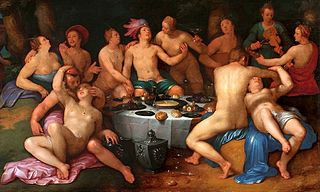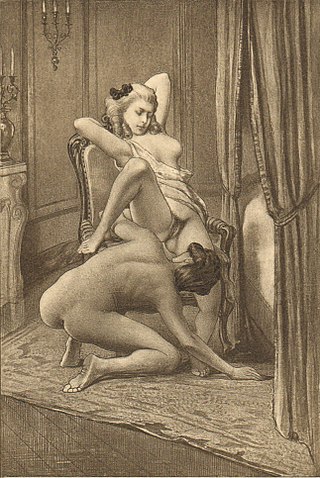
Erotica is art, literature or photography that deals substantively with subject matter that is erotic, sexually stimulating or sexually arousing. Some critics regard pornography as a type of erotica, but many consider it to be different. Erotic art may use any artistic form to depict erotic content, including painting, sculpture, drama, film or music. Erotic literature and erotic photography have become genres in their own right. Erotica also exists in a number of subgenres including gay, lesbian, women's, monster, tentacle erotica and bondage erotica.
The role of sadism and masochism in fiction has attracted serious scholarly attention. Anthony Storr has commented that the volume of sadomasochist pornography shows that sadomasochistic interest is widespread in Western society; John Kucich has noted the importance of masochism in late-19th-century British colonial fiction. This article presents appearances of sadomasochism in literature and works of fiction in the various media.
Theresa Berkley or Berkeley was a 19th-century English dominatrix who ran a brothel in Hallam Street, just to the east of Portland Place, Marylebone, London, specialising in flagellation. She is notable as the inventor of the "chevalet" or "Berkley Horse", a BDSM apparatus.

Erotic literature comprises fictional and factual stories and accounts of eros intended to arouse similar feelings in readers. This contrasts erotica, which focuses more specifically on sexual feelings. Other common elements are satire and social criticism. Much erotic literature features erotic art, illustrating the text.

Henry Spencer Ashbee was a book collector, writer and bibliographer. He is notable for his massive, clandestine three-volume bibliography of erotic literature published under the pseudonym of Pisanus Fraxi.

The Pearl: A Magazine of Facetiae and Voluptuous Reading was a pornographic monthly magazine issued in London during the mid-Victorian period by William Lazenby. It was closed down by the British authorities for violating contemporary standards of obscenity.

Erotic horror, alternately called horror erotica or dark erotica, is a genre of fiction in which sensual or sexual imagery are blended with horrific overtones or story elements for the purpose of sexual titillation. Horror fiction of this type is most common in literature and film.
The Lustful Turk, or Lascivious Scenes from a Harem is a pre-Victorian British exploitation erotic epistolary novel first published anonymously in 1828 by John Benjamin Brookes and reprinted by William Dugdale. However, it was not widely known or circulated until the 1893 edition.
William Simpson Potter was a 19th-century English author. Potter was a friend of Henry Spencer Ashbee, a merchant, bibliographer, bibliophile, authority on the life and works of Miguel de Cervantes, and collector of erotic materials. Ashbee describes Potter as a "shrewd business man, the ardent collector, and the enthusiastic traveller".

My Secret Life, by "Walter", is the memoir of a gentleman describing the author's sexual development and experiences in Victorian England. It was first published in a private edition of eleven volumes, at the expense of the author, including an imperfect index, which appeared over seven years beginning around 1888.
The Sins of the Cities of the Plain; or, The Recollections of a Mary-Ann, with Short Essays on Sodomy and Tribadism, by the pseudonymous "Jack Saul", is one of the first exclusively homosexual works of pornographic literature published in English. The book was first published in 1881 by William Lazenby, who printed 250 copies. A second edition was published by Leonard Smithers in 1902. It sold for an expensive four guineas.
Edward Sellon (1818–1866) was an English writer, translator, and illustrator of erotic literature.
The New Epicurean: The Delights of Sex, Facetiously and Philosophically Considered, in Graphic Letters Addressed to Young Ladies of Quality is a Victorian erotic novel published by William Dugdale in 1865 and attributed to Edward Sellon. The novel is falsely dated "1740", and is written as an eighteenth-century pastiche, composed of a series of letters addressed to various young ladies.
Raped on the Railway: a True Story of a Lady who was first ravished and then flagellated on the Scotch Express is an anonymous English pornographic story published in 1894 by Charles Carrington under the imprint "Society of Bibliophiles" or "Cosmopolitan Bibliophile Society". The victim, a married woman, is raped by a stranger in a locked railway compartment and, in a trope common in later Victorian pornography, is depicted as ultimately taking pleasure in the act: she is then flagellated by her brother-in-law for the latter transgression.
Randiana, or Excitable Tales is an anonymously written pornographic novel originally published by William Lazenby in 1884. The book depicts a variety of sexual activities, including incest, defloration and lesbianism.
The following outline is provided as an overview of and topical guide to human sexuality:

Pornotopia is an idea in critical theory describing an imagined space determined by sexual fantasies and dominated by human sexual activity, expressed in and encompassing erotica and pornography. The word was coined by American literary critic Steven Marcus in his 1966 book The Other Victorians, deriving inspiration from nineteenth-century English literature on sexuality by moralists, physicians and erotic authors.
The Victim of Lust, or Scenes in the Life of Rosa Fielding is an anonymously written Victorian pornographic novel published by William Dugdale in 1867.

Victorian erotica is a genre of sexual art and literature which emerged in the Victorian era of 19th-century Britain. Victorian erotica emerged as a product of a Victorian sexual culture. The Victorian era was characterized by paradox of rigid morality and anti-sensualism, but also by an obsession with sex. Sex was a main social topic, with progressive and enlightened thought pushing for sexual restriction and repression. Overpopulation was a societal concern for the Victorians, thought to be the cause of famine, disease, and war. To curb the threats of overpopulation and to solve other social issues that were arising at the time, sex was socially regulated and controlled. New sexual categories emerged as a response, defining normal and abnormal sex. Heterosexual sex between married couples became the only form of sex socially and morally permissible. Sexual pleasure and desire beyond heterosexual marriage was labelled as deviant, considered to be sinful and sinister. Such deviant forms included masturbation, homosexuality, prostitution and pornography. Procreation was the primary goal of sex, removing it from the public, and placing it in the domestic. Yet, Victorian anti-sexual attitudes were contradictory of genuine Victorian life, with sex underlying much of the cultural practice. Sex was simultaneously repressed and proliferated. Sex was featured in medical manuals such as The Sexual Impulse by Havelock Ellis and Functions and Disorders of Reproductive Organs by William Acton, and in cultural magazines like The Penny Magazine and The Rambler. Sex was popular in entertainment, with much of Victorian theatre, art and literature including and expressing sexual and sensual themes.

Erotic fiction is a part of erotic literature and a genre of fiction that portrays sex or sexual themes, generally in a more literary or serious way than the fiction seen in pornographic magazines. It sometimes includes elements of satire or social criticism. Such works have frequently been banned by the government or religious authorities. Non-fictional works that portray sex or sexual themes may contain fictional elements. Calling an erotic book 'a memoir' is a literary device that is common in this genre. For reasons similar to those that make pseudonyms both commonplace and often deviously set up, the boundary between fiction and non-fiction is broad.








